Ethics of Fashion Essay 2022
VerifiedAdded on 2022/09/28
|9
|2467
|24
Essay
AI Summary
Contribute Materials
Your contribution can guide someone’s learning journey. Share your
documents today.
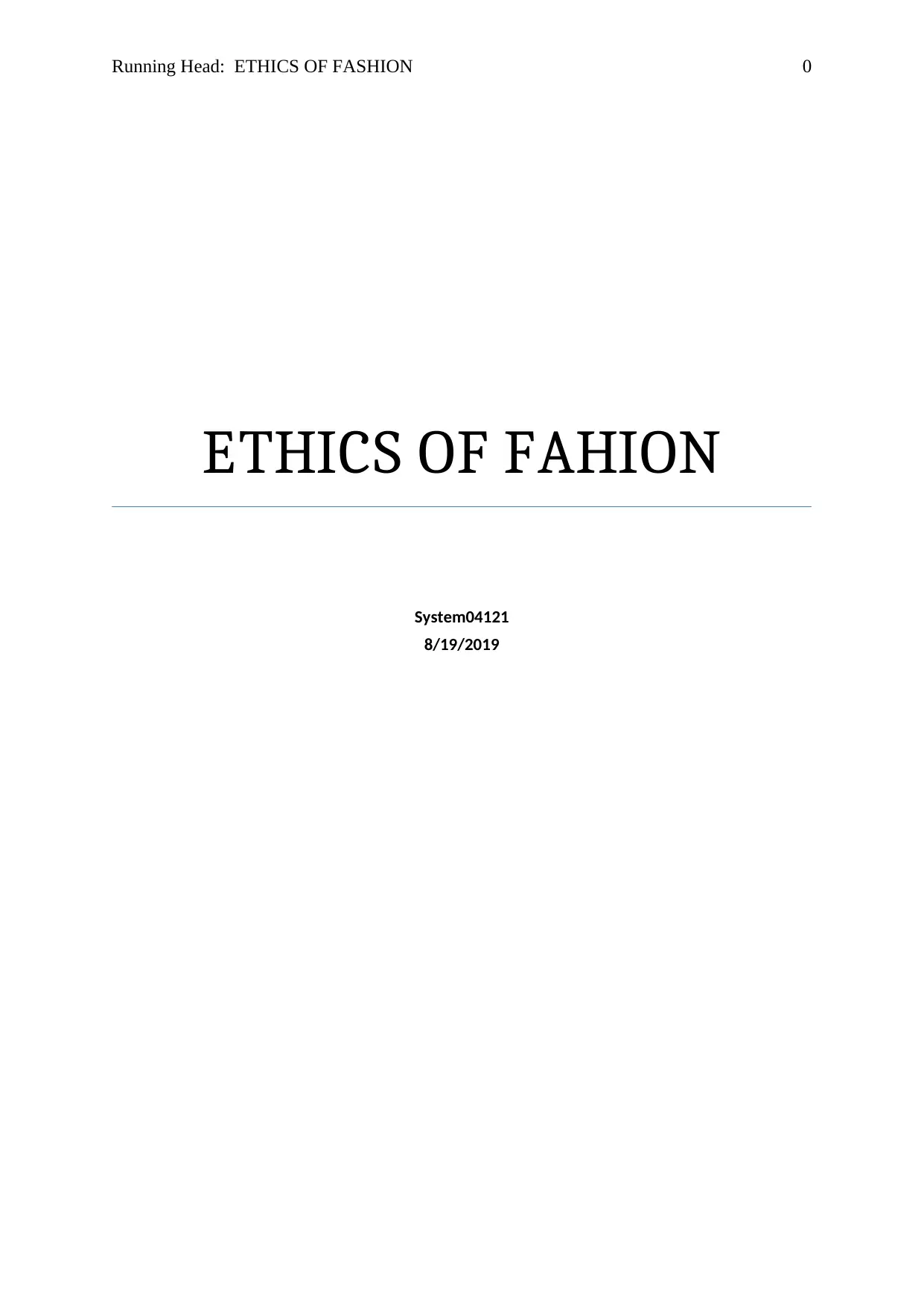
Running Head: ETHICS OF FASHION 0
ETHICS OF FAHION
System04121
8/19/2019
ETHICS OF FAHION
System04121
8/19/2019
Secure Best Marks with AI Grader
Need help grading? Try our AI Grader for instant feedback on your assignments.

ETHICS OF FASHION
1
Fashion today is kind of a necessity for the people as everyone nowadays competes for
looking good. People have their own style and all of them wear some certain clothes in order
to look in a special way (Manchiraju and Sadachar, 2014). All of such thing includes the
latest fashions clothes, accessories, shoes, and handbags. With this happening some persons
have engaged ethical problems by the fashion industry a main worry to them and are
captivating carefulness by only leading business with those that observe ethical practices in
their operations. The fashion industry is one of the most globalised industries and as a
consequence of this the globalization of philosophies, societies, manufactures systems, and
customer systems. However the number of grievances with respect to ethical issues by
clothing industries has been growing and this has been disturbing these companies with
thoughtful allegations on a collection of considerable and imprecise issues of presentation.
Due to high demand in the fashion industry, the production and consumption have led to
some of the negative impacts on the natural resources and the environment as well and as a
result of this the activist of the environment have been going against the fashion industry and
they are also increasing the protest against the fashion industries and companies. This essay
is going to discuss against the ethics of fashion industry. This essay will mainly include the
challenges, opportunities and ethical issues related to the fashion industry (Kozlowski,
Bardecki, and Searcy, 2012).
The customers demand today is not only related to purchasing high quality product, the
customers also focus in the sustainability of the company or an industry. As a result of this
the fashion industry are now facing issues as the fashion industry follows unethical practices
and all this is also effecting the success of fashion industry. Apart from this the fashion
1
Fashion today is kind of a necessity for the people as everyone nowadays competes for
looking good. People have their own style and all of them wear some certain clothes in order
to look in a special way (Manchiraju and Sadachar, 2014). All of such thing includes the
latest fashions clothes, accessories, shoes, and handbags. With this happening some persons
have engaged ethical problems by the fashion industry a main worry to them and are
captivating carefulness by only leading business with those that observe ethical practices in
their operations. The fashion industry is one of the most globalised industries and as a
consequence of this the globalization of philosophies, societies, manufactures systems, and
customer systems. However the number of grievances with respect to ethical issues by
clothing industries has been growing and this has been disturbing these companies with
thoughtful allegations on a collection of considerable and imprecise issues of presentation.
Due to high demand in the fashion industry, the production and consumption have led to
some of the negative impacts on the natural resources and the environment as well and as a
result of this the activist of the environment have been going against the fashion industry and
they are also increasing the protest against the fashion industries and companies. This essay
is going to discuss against the ethics of fashion industry. This essay will mainly include the
challenges, opportunities and ethical issues related to the fashion industry (Kozlowski,
Bardecki, and Searcy, 2012).
The customers demand today is not only related to purchasing high quality product, the
customers also focus in the sustainability of the company or an industry. As a result of this
the fashion industry are now facing issues as the fashion industry follows unethical practices
and all this is also effecting the success of fashion industry. Apart from this the fashion

ETHICS OF FASHION
2
industry will have to work hard in order to attract the customers. The fashion industry is now
dealing with various environmental and social issues (Niinimäki, and Hassi, 2011).
In today’s world of fashion industry the expectations of the customers are increasing in
relative to the social accountability and ethical practices of the company as in the persons are
now focusing a lot on what they are trying. According to a study which was conducted in
the United Kingdom in the year 2014 on the ethical consumerism. It was seen that around 2%
consumers shopped for the clothes for the moral reasons as linked to the report of 2002 which
was 27%. The customers are nowadays focusing more on reliable background and practices
of the products they are purchasing from the market. Also the customers are highly focusing
on the activities of the company or an industry related to its supply chain.
Some of the issues which are affecting the performance of the fashion industry are, the first
one is the environmental issues. The customers nowadays wants to connect with the
companies who have incorporated trade practices and the industries which do not cause any
damage to the environment or the workers by means of things like organic and biodegradable
fabrics.
The most important environmental factor that is affecting the fashion industry is the
dangerous impact of the environment. The industry of fashion is highly responsible for
environment pollution; it comes on the second position after the oil industry. The company
contributes to the high level of waste and disposals that increase the shortage of natural
resources (Choi, Shen, and Shum et al, 2012). Apart from this due to high demand of the
customers the industry produces low quality products which have let to the use of artificial
fibres and unsafe dyes and all this has led to negative impact on the environment. Another
2
industry will have to work hard in order to attract the customers. The fashion industry is now
dealing with various environmental and social issues (Niinimäki, and Hassi, 2011).
In today’s world of fashion industry the expectations of the customers are increasing in
relative to the social accountability and ethical practices of the company as in the persons are
now focusing a lot on what they are trying. According to a study which was conducted in
the United Kingdom in the year 2014 on the ethical consumerism. It was seen that around 2%
consumers shopped for the clothes for the moral reasons as linked to the report of 2002 which
was 27%. The customers are nowadays focusing more on reliable background and practices
of the products they are purchasing from the market. Also the customers are highly focusing
on the activities of the company or an industry related to its supply chain.
Some of the issues which are affecting the performance of the fashion industry are, the first
one is the environmental issues. The customers nowadays wants to connect with the
companies who have incorporated trade practices and the industries which do not cause any
damage to the environment or the workers by means of things like organic and biodegradable
fabrics.
The most important environmental factor that is affecting the fashion industry is the
dangerous impact of the environment. The industry of fashion is highly responsible for
environment pollution; it comes on the second position after the oil industry. The company
contributes to the high level of waste and disposals that increase the shortage of natural
resources (Choi, Shen, and Shum et al, 2012). Apart from this due to high demand of the
customers the industry produces low quality products which have let to the use of artificial
fibres and unsafe dyes and all this has led to negative impact on the environment. Another
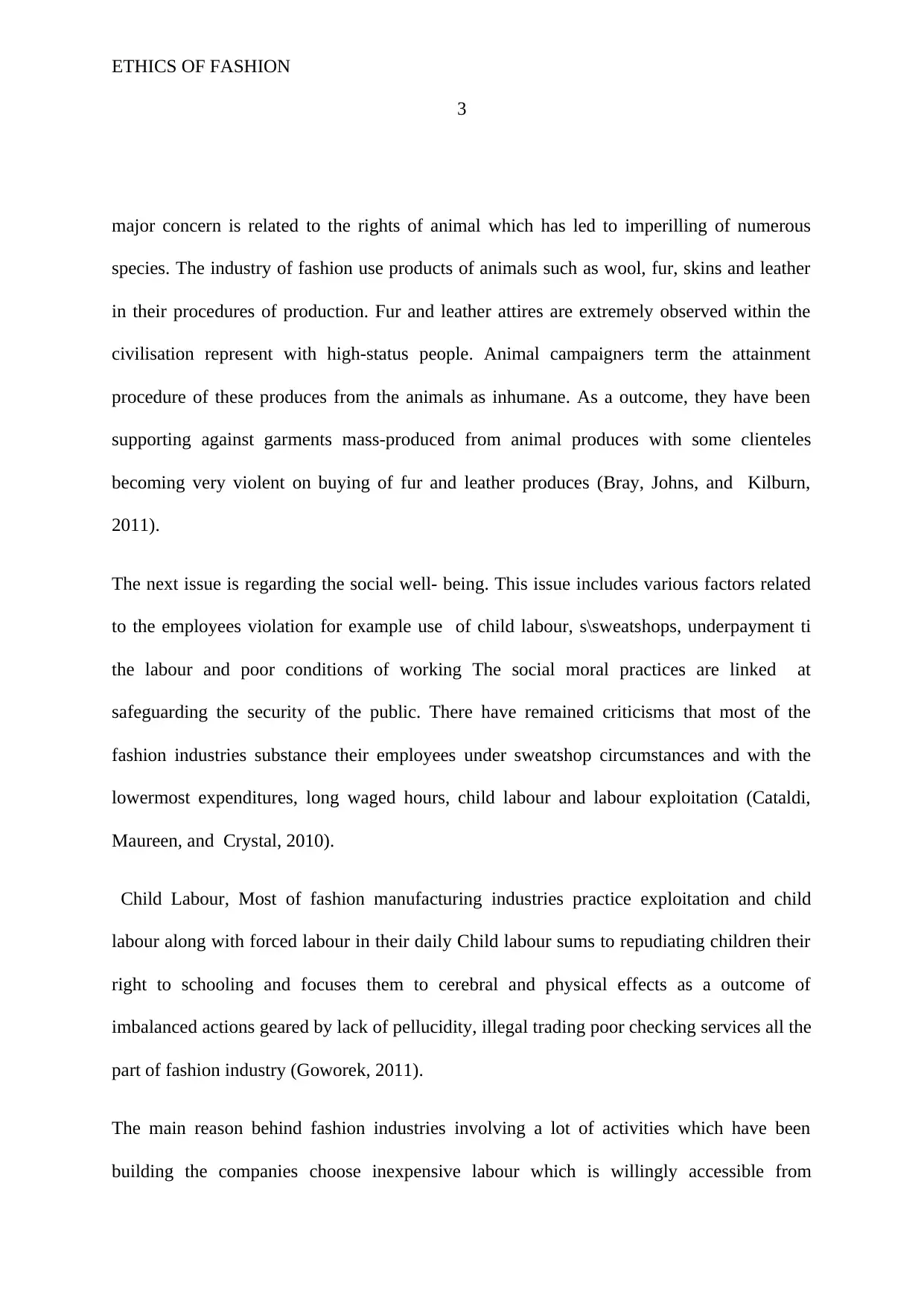
ETHICS OF FASHION
3
major concern is related to the rights of animal which has led to imperilling of numerous
species. The industry of fashion use products of animals such as wool, fur, skins and leather
in their procedures of production. Fur and leather attires are extremely observed within the
civilisation represent with high-status people. Animal campaigners term the attainment
procedure of these produces from the animals as inhumane. As a outcome, they have been
supporting against garments mass-produced from animal produces with some clienteles
becoming very violent on buying of fur and leather produces (Bray, Johns, and Kilburn,
2011).
The next issue is regarding the social well- being. This issue includes various factors related
to the employees violation for example use of child labour, s\sweatshops, underpayment ti
the labour and poor conditions of working The social moral practices are linked at
safeguarding the security of the public. There have remained criticisms that most of the
fashion industries substance their employees under sweatshop circumstances and with the
lowermost expenditures, long waged hours, child labour and labour exploitation (Cataldi,
Maureen, and Crystal, 2010).
Child Labour, Most of fashion manufacturing industries practice exploitation and child
labour along with forced labour in their daily Child labour sums to repudiating children their
right to schooling and focuses them to cerebral and physical effects as a outcome of
imbalanced actions geared by lack of pellucidity, illegal trading poor checking services all the
part of fashion industry (Goworek, 2011).
The main reason behind fashion industries involving a lot of activities which have been
building the companies choose inexpensive labour which is willingly accessible from
3
major concern is related to the rights of animal which has led to imperilling of numerous
species. The industry of fashion use products of animals such as wool, fur, skins and leather
in their procedures of production. Fur and leather attires are extremely observed within the
civilisation represent with high-status people. Animal campaigners term the attainment
procedure of these produces from the animals as inhumane. As a outcome, they have been
supporting against garments mass-produced from animal produces with some clienteles
becoming very violent on buying of fur and leather produces (Bray, Johns, and Kilburn,
2011).
The next issue is regarding the social well- being. This issue includes various factors related
to the employees violation for example use of child labour, s\sweatshops, underpayment ti
the labour and poor conditions of working The social moral practices are linked at
safeguarding the security of the public. There have remained criticisms that most of the
fashion industries substance their employees under sweatshop circumstances and with the
lowermost expenditures, long waged hours, child labour and labour exploitation (Cataldi,
Maureen, and Crystal, 2010).
Child Labour, Most of fashion manufacturing industries practice exploitation and child
labour along with forced labour in their daily Child labour sums to repudiating children their
right to schooling and focuses them to cerebral and physical effects as a outcome of
imbalanced actions geared by lack of pellucidity, illegal trading poor checking services all the
part of fashion industry (Goworek, 2011).
The main reason behind fashion industries involving a lot of activities which have been
building the companies choose inexpensive labour which is willingly accessible from
Paraphrase This Document
Need a fresh take? Get an instant paraphrase of this document with our AI Paraphraser
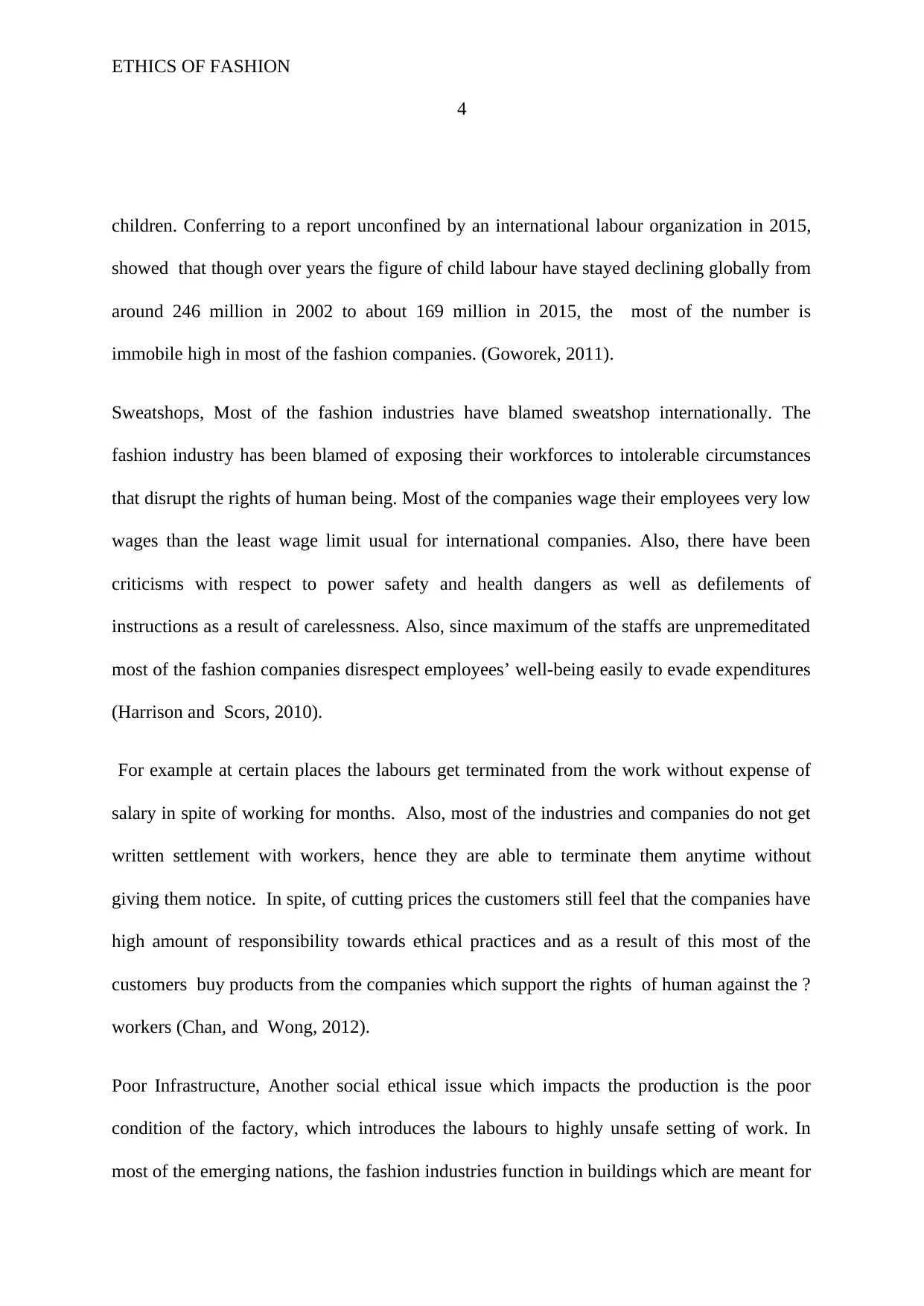
ETHICS OF FASHION
4
children. Conferring to a report unconfined by an international labour organization in 2015,
showed that though over years the figure of child labour have stayed declining globally from
around 246 million in 2002 to about 169 million in 2015, the most of the number is
immobile high in most of the fashion companies. (Goworek, 2011).
Sweatshops, Most of the fashion industries have blamed sweatshop internationally. The
fashion industry has been blamed of exposing their workforces to intolerable circumstances
that disrupt the rights of human being. Most of the companies wage their employees very low
wages than the least wage limit usual for international companies. Also, there have been
criticisms with respect to power safety and health dangers as well as defilements of
instructions as a result of carelessness. Also, since maximum of the staffs are unpremeditated
most of the fashion companies disrespect employees’ well-being easily to evade expenditures
(Harrison and Scors, 2010).
For example at certain places the labours get terminated from the work without expense of
salary in spite of working for months. Also, most of the industries and companies do not get
written settlement with workers, hence they are able to terminate them anytime without
giving them notice. In spite, of cutting prices the customers still feel that the companies have
high amount of responsibility towards ethical practices and as a result of this most of the
customers buy products from the companies which support the rights of human against the ?
workers (Chan, and Wong, 2012).
Poor Infrastructure, Another social ethical issue which impacts the production is the poor
condition of the factory, which introduces the labours to highly unsafe setting of work. In
most of the emerging nations, the fashion industries function in buildings which are meant for
4
children. Conferring to a report unconfined by an international labour organization in 2015,
showed that though over years the figure of child labour have stayed declining globally from
around 246 million in 2002 to about 169 million in 2015, the most of the number is
immobile high in most of the fashion companies. (Goworek, 2011).
Sweatshops, Most of the fashion industries have blamed sweatshop internationally. The
fashion industry has been blamed of exposing their workforces to intolerable circumstances
that disrupt the rights of human being. Most of the companies wage their employees very low
wages than the least wage limit usual for international companies. Also, there have been
criticisms with respect to power safety and health dangers as well as defilements of
instructions as a result of carelessness. Also, since maximum of the staffs are unpremeditated
most of the fashion companies disrespect employees’ well-being easily to evade expenditures
(Harrison and Scors, 2010).
For example at certain places the labours get terminated from the work without expense of
salary in spite of working for months. Also, most of the industries and companies do not get
written settlement with workers, hence they are able to terminate them anytime without
giving them notice. In spite, of cutting prices the customers still feel that the companies have
high amount of responsibility towards ethical practices and as a result of this most of the
customers buy products from the companies which support the rights of human against the ?
workers (Chan, and Wong, 2012).
Poor Infrastructure, Another social ethical issue which impacts the production is the poor
condition of the factory, which introduces the labours to highly unsafe setting of work. In
most of the emerging nations, the fashion industries function in buildings which are meant for
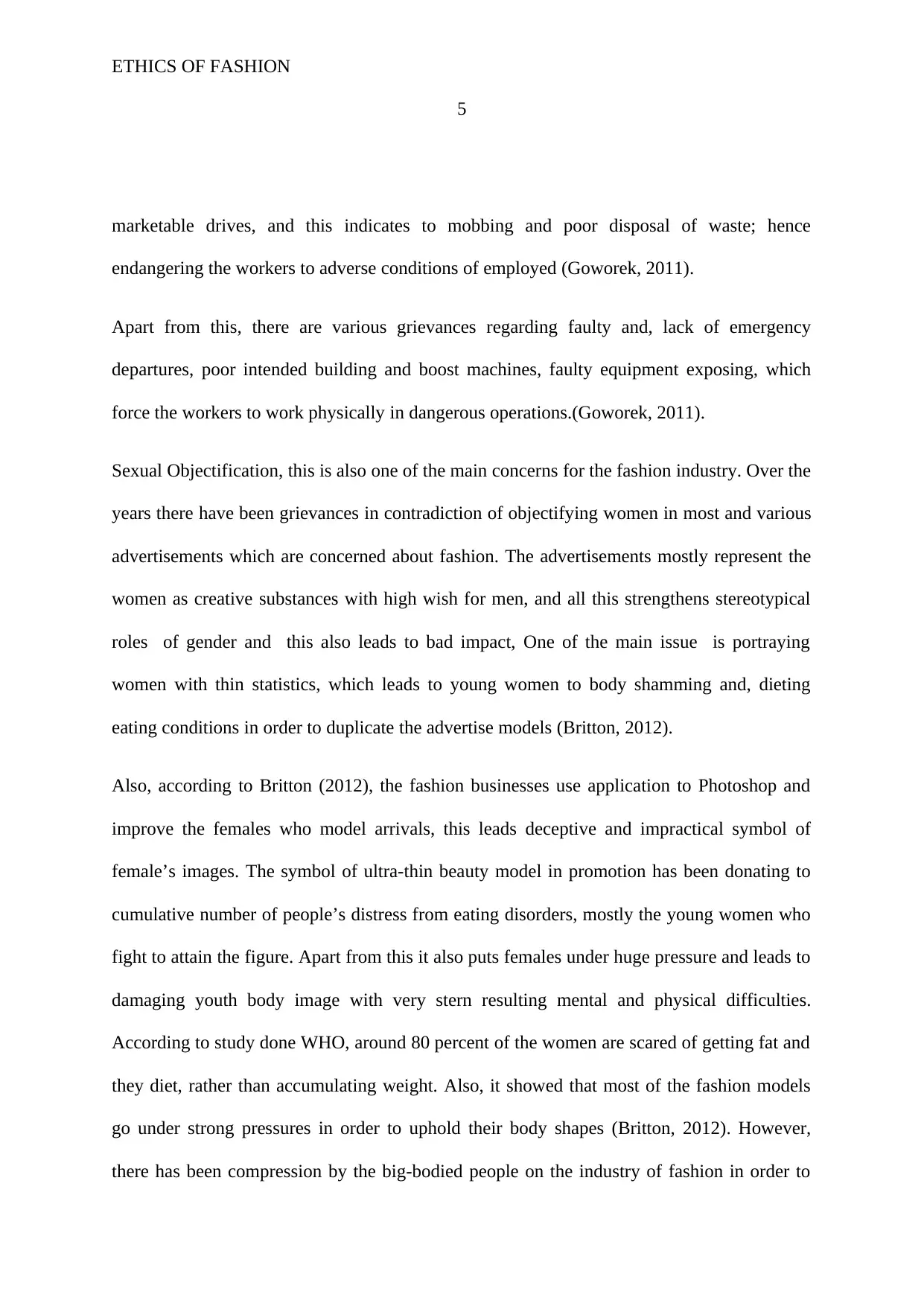
ETHICS OF FASHION
5
marketable drives, and this indicates to mobbing and poor disposal of waste; hence
endangering the workers to adverse conditions of employed (Goworek, 2011).
Apart from this, there are various grievances regarding faulty and, lack of emergency
departures, poor intended building and boost machines, faulty equipment exposing, which
force the workers to work physically in dangerous operations.(Goworek, 2011).
Sexual Objectification, this is also one of the main concerns for the fashion industry. Over the
years there have been grievances in contradiction of objectifying women in most and various
advertisements which are concerned about fashion. The advertisements mostly represent the
women as creative substances with high wish for men, and all this strengthens stereotypical
roles of gender and this also leads to bad impact, One of the main issue is portraying
women with thin statistics, which leads to young women to body shamming and, dieting
eating conditions in order to duplicate the advertise models (Britton, 2012).
Also, according to Britton (2012), the fashion businesses use application to Photoshop and
improve the females who model arrivals, this leads deceptive and impractical symbol of
female’s images. The symbol of ultra-thin beauty model in promotion has been donating to
cumulative number of people’s distress from eating disorders, mostly the young women who
fight to attain the figure. Apart from this it also puts females under huge pressure and leads to
damaging youth body image with very stern resulting mental and physical difficulties.
According to study done WHO, around 80 percent of the women are scared of getting fat and
they diet, rather than accumulating weight. Also, it showed that most of the fashion models
go under strong pressures in order to uphold their body shapes (Britton, 2012). However,
there has been compression by the big-bodied people on the industry of fashion in order to
5
marketable drives, and this indicates to mobbing and poor disposal of waste; hence
endangering the workers to adverse conditions of employed (Goworek, 2011).
Apart from this, there are various grievances regarding faulty and, lack of emergency
departures, poor intended building and boost machines, faulty equipment exposing, which
force the workers to work physically in dangerous operations.(Goworek, 2011).
Sexual Objectification, this is also one of the main concerns for the fashion industry. Over the
years there have been grievances in contradiction of objectifying women in most and various
advertisements which are concerned about fashion. The advertisements mostly represent the
women as creative substances with high wish for men, and all this strengthens stereotypical
roles of gender and this also leads to bad impact, One of the main issue is portraying
women with thin statistics, which leads to young women to body shamming and, dieting
eating conditions in order to duplicate the advertise models (Britton, 2012).
Also, according to Britton (2012), the fashion businesses use application to Photoshop and
improve the females who model arrivals, this leads deceptive and impractical symbol of
female’s images. The symbol of ultra-thin beauty model in promotion has been donating to
cumulative number of people’s distress from eating disorders, mostly the young women who
fight to attain the figure. Apart from this it also puts females under huge pressure and leads to
damaging youth body image with very stern resulting mental and physical difficulties.
According to study done WHO, around 80 percent of the women are scared of getting fat and
they diet, rather than accumulating weight. Also, it showed that most of the fashion models
go under strong pressures in order to uphold their body shapes (Britton, 2012). However,
there has been compression by the big-bodied people on the industry of fashion in order to
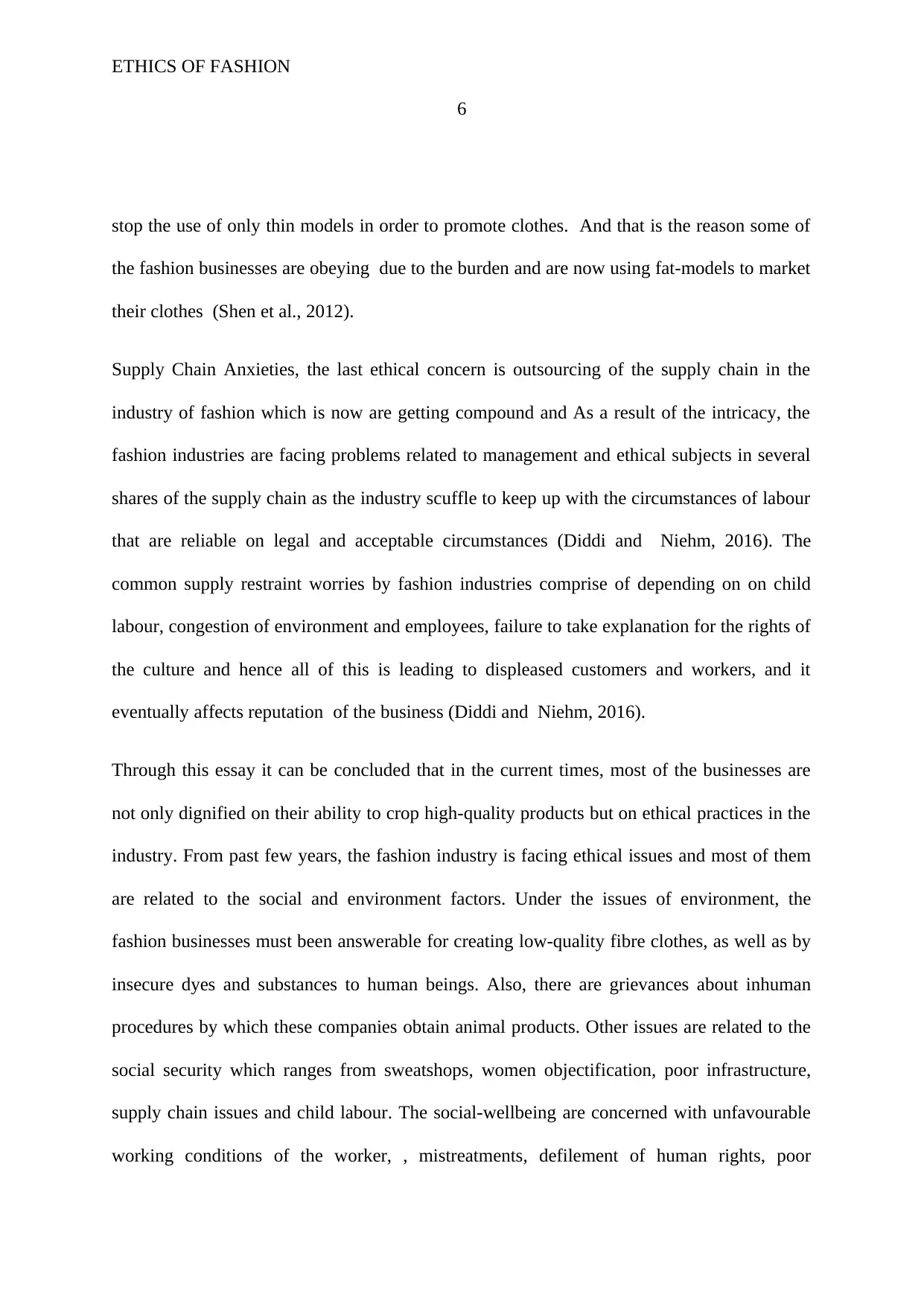
ETHICS OF FASHION
6
stop the use of only thin models in order to promote clothes. And that is the reason some of
the fashion businesses are obeying due to the burden and are now using fat-models to market
their clothes (Shen et al., 2012).
Supply Chain Anxieties, the last ethical concern is outsourcing of the supply chain in the
industry of fashion which is now are getting compound and As a result of the intricacy, the
fashion industries are facing problems related to management and ethical subjects in several
shares of the supply chain as the industry scuffle to keep up with the circumstances of labour
that are reliable on legal and acceptable circumstances (Diddi and Niehm, 2016). The
common supply restraint worries by fashion industries comprise of depending on on child
labour, congestion of environment and employees, failure to take explanation for the rights of
the culture and hence all of this is leading to displeased customers and workers, and it
eventually affects reputation of the business (Diddi and Niehm, 2016).
Through this essay it can be concluded that in the current times, most of the businesses are
not only dignified on their ability to crop high-quality products but on ethical practices in the
industry. From past few years, the fashion industry is facing ethical issues and most of them
are related to the social and environment factors. Under the issues of environment, the
fashion businesses must been answerable for creating low-quality fibre clothes, as well as by
insecure dyes and substances to human beings. Also, there are grievances about inhuman
procedures by which these companies obtain animal products. Other issues are related to the
social security which ranges from sweatshops, women objectification, poor infrastructure,
supply chain issues and child labour. The social-wellbeing are concerned with unfavourable
working conditions of the worker, , mistreatments, defilement of human rights, poor
6
stop the use of only thin models in order to promote clothes. And that is the reason some of
the fashion businesses are obeying due to the burden and are now using fat-models to market
their clothes (Shen et al., 2012).
Supply Chain Anxieties, the last ethical concern is outsourcing of the supply chain in the
industry of fashion which is now are getting compound and As a result of the intricacy, the
fashion industries are facing problems related to management and ethical subjects in several
shares of the supply chain as the industry scuffle to keep up with the circumstances of labour
that are reliable on legal and acceptable circumstances (Diddi and Niehm, 2016). The
common supply restraint worries by fashion industries comprise of depending on on child
labour, congestion of environment and employees, failure to take explanation for the rights of
the culture and hence all of this is leading to displeased customers and workers, and it
eventually affects reputation of the business (Diddi and Niehm, 2016).
Through this essay it can be concluded that in the current times, most of the businesses are
not only dignified on their ability to crop high-quality products but on ethical practices in the
industry. From past few years, the fashion industry is facing ethical issues and most of them
are related to the social and environment factors. Under the issues of environment, the
fashion businesses must been answerable for creating low-quality fibre clothes, as well as by
insecure dyes and substances to human beings. Also, there are grievances about inhuman
procedures by which these companies obtain animal products. Other issues are related to the
social security which ranges from sweatshops, women objectification, poor infrastructure,
supply chain issues and child labour. The social-wellbeing are concerned with unfavourable
working conditions of the worker, , mistreatments, defilement of human rights, poor
Secure Best Marks with AI Grader
Need help grading? Try our AI Grader for instant feedback on your assignments.
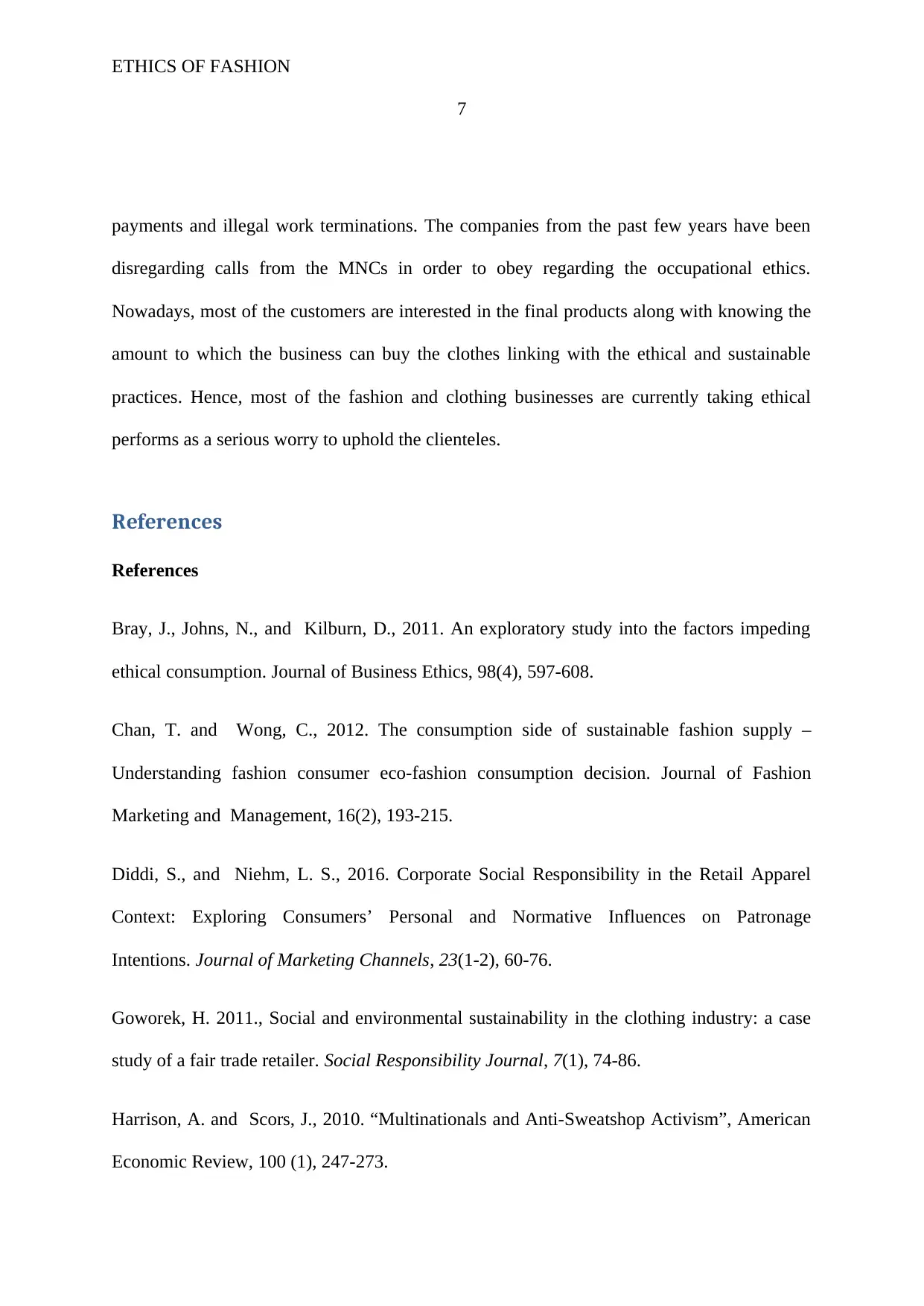
ETHICS OF FASHION
7
payments and illegal work terminations. The companies from the past few years have been
disregarding calls from the MNCs in order to obey regarding the occupational ethics.
Nowadays, most of the customers are interested in the final products along with knowing the
amount to which the business can buy the clothes linking with the ethical and sustainable
practices. Hence, most of the fashion and clothing businesses are currently taking ethical
performs as a serious worry to uphold the clienteles.
References
References
Bray, J., Johns, N., and Kilburn, D., 2011. An exploratory study into the factors impeding
ethical consumption. Journal of Business Ethics, 98(4), 597-608.
Chan, T. and Wong, C., 2012. The consumption side of sustainable fashion supply –
Understanding fashion consumer eco-fashion consumption decision. Journal of Fashion
Marketing and Management, 16(2), 193-215.
Diddi, S., and Niehm, L. S., 2016. Corporate Social Responsibility in the Retail Apparel
Context: Exploring Consumers’ Personal and Normative Influences on Patronage
Intentions. Journal of Marketing Channels, 23(1-2), 60-76.
Goworek, H. 2011., Social and environmental sustainability in the clothing industry: a case
study of a fair trade retailer. Social Responsibility Journal, 7(1), 74-86.
Harrison, A. and Scors, J., 2010. “Multinationals and Anti-Sweatshop Activism”, American
Economic Review, 100 (1), 247-273.
7
payments and illegal work terminations. The companies from the past few years have been
disregarding calls from the MNCs in order to obey regarding the occupational ethics.
Nowadays, most of the customers are interested in the final products along with knowing the
amount to which the business can buy the clothes linking with the ethical and sustainable
practices. Hence, most of the fashion and clothing businesses are currently taking ethical
performs as a serious worry to uphold the clienteles.
References
References
Bray, J., Johns, N., and Kilburn, D., 2011. An exploratory study into the factors impeding
ethical consumption. Journal of Business Ethics, 98(4), 597-608.
Chan, T. and Wong, C., 2012. The consumption side of sustainable fashion supply –
Understanding fashion consumer eco-fashion consumption decision. Journal of Fashion
Marketing and Management, 16(2), 193-215.
Diddi, S., and Niehm, L. S., 2016. Corporate Social Responsibility in the Retail Apparel
Context: Exploring Consumers’ Personal and Normative Influences on Patronage
Intentions. Journal of Marketing Channels, 23(1-2), 60-76.
Goworek, H. 2011., Social and environmental sustainability in the clothing industry: a case
study of a fair trade retailer. Social Responsibility Journal, 7(1), 74-86.
Harrison, A. and Scors, J., 2010. “Multinationals and Anti-Sweatshop Activism”, American
Economic Review, 100 (1), 247-273.

ETHICS OF FASHION
8
Kozlowski, A., Bardecki, M., and Searcy, C. 2012. “Environmental impacts in the fashion
industry”, Journal of Corporate Citizenship, 45, 16-36.
Niinimäki, K., and Hassi, L., 2011. Emerging design strategies in sustainable production and
consumption of textiles and clothing. Journal of Cleaner Production, 19(16), 1876-1883.
Shen, B., Wang, Y., Lo, C. K., and Shum, M. 2012. The impact of ethical fashion on
consumer purchase behavior. Journal of Fashion Marketing and Management: An
International Journal, 16(2), 234-245.
Choi, T.M., Lo, C.K., Wong, C.W., Yee, R.W., Shen, B., Wang, Y. and Shum, M., 2012. The
impact of ethical fashion on consumer purchase behavior. Journal of Fashion Marketing and
Management: An International Journal.
Manchiraju, S. and Sadachar, A., 2014. Personal values and ethical fashion
consumption. Journal of Fashion Marketing and Management, 18(3), pp.357-374.
8
Kozlowski, A., Bardecki, M., and Searcy, C. 2012. “Environmental impacts in the fashion
industry”, Journal of Corporate Citizenship, 45, 16-36.
Niinimäki, K., and Hassi, L., 2011. Emerging design strategies in sustainable production and
consumption of textiles and clothing. Journal of Cleaner Production, 19(16), 1876-1883.
Shen, B., Wang, Y., Lo, C. K., and Shum, M. 2012. The impact of ethical fashion on
consumer purchase behavior. Journal of Fashion Marketing and Management: An
International Journal, 16(2), 234-245.
Choi, T.M., Lo, C.K., Wong, C.W., Yee, R.W., Shen, B., Wang, Y. and Shum, M., 2012. The
impact of ethical fashion on consumer purchase behavior. Journal of Fashion Marketing and
Management: An International Journal.
Manchiraju, S. and Sadachar, A., 2014. Personal values and ethical fashion
consumption. Journal of Fashion Marketing and Management, 18(3), pp.357-374.
1 out of 9
![[object Object]](/_next/static/media/star-bottom.7253800d.svg)





